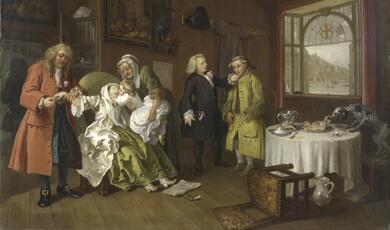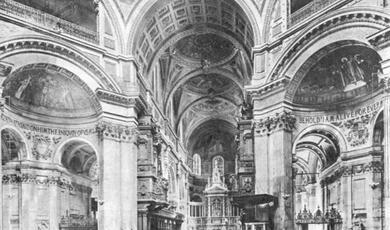Poetry & Remembrance: Thomas Gray's Elegy Written in a Country Churchyard
Share
- Details
- Text
- Audio
- Downloads
- Extra Reading
There are two versions of Gray’s famous ‘Elegy written in a Country Churchyard’. They are both about how we may be remembered, a thought that often comes to us when we’re in a graveyard reading gravestones. But the poem is also about more common experiences, of isolation, of family, of ambition. Why did Gray write two versions?
Download Text
14 April 2015
Poetry and Remembrance:
Thomas Gray’s Elegy Written in a Country Churchyard
Professor Belinda Jack
Good evening and welcome. For those who haven’t been before, this is eleventh of a series of sixteen lectures on ‘the mysteries of reading and writing’. In the first six I explored reading as an activity, its history and how the manner in which we red and what we read has changed over time. I then gave four lectures on the novel as a genre, a peculiarly ‘baggy’ genre into which all sorts of human experience and ideas can be bundled. We considered various themes in relation to the four novels – morality, political history, idealism and human psychology. Tonight I will be giving the first of four lectures on poetry. Unlike the language of prose, the language of poetry is endlessly flexible. Prose is generally grammatically correct whereas poetry can break all the rules. Prose is linear – words make sense read across the page from left to right. In poetry, techniques like rhyme create links within lines or between lines – in the case of terminal rhymes. So tonight we embark on an exploration of Gray’s ‘Elegy Written in a Country Churchyard’ asking two seemingly simple questions: ‘In what sense is the elegy about ‘remembering’ and ‘remembrance’, and why is it deemed such a great poem?’
Thomas Gray was born in Cornhill, Londonon December 26, 1716. His father, Philip Gray, was a scrivener here in the City of London (arranging for the loan of money to others) and his mother, Dorothy Antrobus, was a milliner. He was the fifth of 12 children, but the only one to survive infancy. He lived with his mother after his parents separated. He was educated at Eton College where two of his uncles were schoolmasters. Gray was studious and disliked sports. At Eton he made three important friends: Horace Walpole, writer, politician and antiquarian, son of the Prime Minister Robert Walpole[Horace Walpole by Joshua Reynolds 1756, National Portrait Gallery, London], and Richard West, who went on to be a brilliant lawyer, son of another Richard West, briefly Lord Chancellor of Ireland. In 1734 Gray went up to Peterhouse, Cambridgewhich he didn’t much enjoy. He thought the teaching poor and spent most of his time, as he had at Eton, reading literature both classical and modern – and playing the harpsichord! [You heard a recording of Scarlatti on harpsichord at beginning and will hear Vivaldi on harpsichord at end]
In 1738 he and Walpole set off on a Grand Tour of Europe but in Tuscany the two young men quarreled and went their separate ways. They were reconciled some years later and it was to Walpole that Gray first sent his famous Elegy and Walpole sent it on to several magazines.
Gray began writing poems in earnest in the 1740s. He moved back to Cambridge and embarked on a systematic study of literature, history and political writings. His contemporaries considered him one of the most learned men of his generation. He became a Fellow of Peterhouse, and later of Pembroke Hall (now Pembroke College).
Gray is generally considered to be one of the outstanding English poets of the eighteenth century yet his oeuvre is small, fewer than 1,000 lines. His published poetry amounts to only thirteen pieces. This is usually explained in terms of Gray’s highly self-critical nature and his acute fear of failure. In 1768 he was elected Regius Professor of Modern History at Cambridge. He died on 30 July, 1771 in Cambridge, and was buried beside his mother in the St Giles churchyard at Stoke Poges, the setting some commentators claim to have been the inspiration for his famous Elegy. [Constable’s watercolour of Stoke P, 1833; victorian prints:Muttering his wayward Fancies, would he rove by John Dawson Watson. Wood-engraving by the Dalziels, 3 13/6 x 3 1/2 inches. 1862. An illustration for Thomas Gray's "Elegy Written in a Country Churchyard.Robert Tanner, 1980]
Let’s hear a reading of the Elegy by Michael Burrell:
http://www.thomasgray.org.uk/texts/diglib.shtml#avm
Why did Gray choose ‘elegy’; form?
The Greek term elegeia (from the Greek, elegos, ‘lament’) originally referred to any verse written in elegiac couplets (gloss) and covering a wide range of subject matter (death, love, war).
In English literature, the more modern and restricted meaning of a lament for a departed loved one or for a tragic event, comes in during the sixteenth century.
Elegy is generally considered to be a form of poetry which lends itself to contemplation or reflection. Its subject can be various but it must be treated not for itself but always in relation to the poet. The emphasis is on an absence, either a regret for something or someone lost in the past or a desire for an as yet unfulfilled future. Elegy presents things as lost and past, or absent and future.
The dating of the composition of the published Elegy is a source of considerable scholarly debate. The most convincing theory, it seems to me, attempts to establish allusions in the ‘Elegy’ to other poems of the 1740s: Young’s ‘Night Thought’(1742-45); Blair’s ‘The Grave’ (1743); James Hervey’s ‘Meditations among the Tombs’ (1746)
It has also been argued that there is some relationship between the ‘Elegy’ and Gray’s fragment entitled ‘Education and Government’ (‘47/’48). Both poems deal with the subject of genius which has been prevented from flourishing because of circumstance, and both may be related to Plato’s discussion of education and its effect on ‘virtue’, which Gray was reading at the time.
What we do know for certain is that Gray sent the completed poem to Horace Walpole on 12 June, 1750; and that it was published that year.
The most important exegetical fact or piece of interpretive evidence, by no means always taken into consideration by commentators on the ‘Elegy’ is that it exists in the two distinct versions. The first is known as ‘The Eton manuscript’ and is entitled ‘Stanza’s Wrote in a Country Church-Yard’. It was never published and having passed through the hands of various salerooms, ended up a gift to Eton College. The first 18 stanzas are substantially the same as the published Elegy. The last 4 stanzas of ‘Stanza’s Wrote in a Country Church-Yard’ were rejected by Gray and replaced in the ‘Elegy’.
Some critics have claimed that the first version is arguably complete and in some ways more balanced than the final Elegy. The first three stanzas set the poem and the poet in the graveyard. Then follow four balanced stanzas:
The lives of the humble villagers
The lives of the famous
The ways in which the villagers are prevented from becoming famous
The crimes inextricably involved in ‘success’ as the ‘thoughtless world’ understands it, from which the villagers are immune.
The last three balance with the first three. There is a return to the poet as subject, ‘making clear that the whole poem has been a debate within his [the poet’s] mind as he meditates in the darkness’ (Roger Lonsdale, p. 114).
The poet then makes his choice: his preference for obscure innocence over the hazards of the ‘great world’. This establishes the poet’s desire to share the obscure destiny of the villagers.[ ; this that makes Marxist readings of the Elegy suspect?]
There are allusions in ‘Stanzas…’ to 3 classical poems that celebrate rural retirement from the corruption of the court and the city: Virgil’s Georgics ii 458 ff (‘O fortunatos nimium’) and Horace’s second Epode (Beatus ille…). In the concluding, ‘rejected’, stanzas of the first version, the classical praise of retirement is successfully blended with the Christian consolation that this world is nothing but vanity and that comfort for the tormented will come in the next, although G’s handling of the Christian vision is reserved.
So why was G dissatisfied with this finely-balanced, restrained Augustan poem?
There are a number of possible answers:
It was too explicitly personal for publication?
Or it could also be that the very symmetry and order of the poem suggest a reductiveness and over-simplification of his predicament, of his life, and how he wanted it to be seen by society. The great Gray critic and editor Roger Lonsdale writes, ‘A simple identification with the innocent but uneducated villagers was mere self-deception’.(Lonsdale, p.115) All readings of Gray’s poetry are indebted to Lonsdale’s wonderful edition which provides a page of footnotes for each line or two of poetry.
The ‘Elegy’ is complicated by Gray’s attempt to integrate his role in society with the social role played by poetry or the Poet, almost as abstracts. In re-writing the poem some of the straightforward antithetical pairings between rich and poor, between vice and virtue, between life and death, are replaced by a preoccupation with the desire to be remembered after death, a concern that draws together rich and poor, making both the extravagant monuments and ‘frail memorials’ equally pathetic.
This is a departure from the earlier resignation to obscurity and ‘eternal peace’, and making common cause with the poor. Now he contemplates how he may be remembered – or the Poet with whom he identifies – may be remembered after death – and the assessments he gives in the words of the ‘hoary-headed swain’ and of the ‘Epitaph’ (not necessarily one and the same) also evaluate the role of poetry and the Poet in society. The Poet is cast as an outsider, with a particular sensibility, imagination and consciousness at once uniquely creative but, equally, burdensome. In mid- and late eighteenth- century England poetry had no real social function and this leads to a search for inspiration from the past. There are borrowings from the classics, from Spenser, Shakespeare and Milton most notably. The Swain’s perspective is respectful, if lacking in real understanding; the Epitaph at the end of the poem explores the relationship between sensibility and certain social virtues like pity, sympathy, and benevolence.
The poem ends with an assertion that whilst there is an inseparable connection between poetry and liberty in society, there are forces hostile to poetry. The venture is isolated and ultimately doomed.
However, the poem proved to be extraordinarily successful. The Monthly Review iv 309, Feb. 1751 commented that, ‘This excellent little piece is so much read, and so much admired by everybody, that to say more of it would be superfluous.’ 12 editions by 1763.
I’ll begin with an analysis of the poem. Here I’d like to acknowledge a debt to an excellent article by W. Hutchings, ‘Syntax of Death: Instability in Gray’s Elegy Written in a Country Churchyard’ (University of North Carolina Press, 1984), although my conclusions differ from his. And also, as I mentioned earlier, to Roger Lonsdale’s scholarly edition.
‘The curfew tolls the knell of parting day,’ [‘knell’, the sound of a bell, especially when rung solemnly for a death or funeral
Here four words serve to reinforce each other – curfew, tolls, knell, parting day - rather than qualifying each other’s meaning.
The tolling of a bell had become, by Gray’s time, associated with the ‘parting bell’, the bell which sounds at a funeral. In Shakespeare’s Henry IV, part 2 there is a bell ‘tolling a departing friend’.
There is a degree of superfluity in the line.
Wouldn’t ‘The curfew tolls the knell of day’ be sufficient; or even, ‘The curfew tolls for parting day’, or even, ‘The curfew tolls the day’ or simply, ‘The curfew tolls’?
There are other peculiarities about this opening line. The verb ‘tolls’ can be read as both a transitive and an intransitive verb; as George Watson notes, the verb has the ‘odd property of facing both ways’ (George Watson, ‘The Voice of Gray’, CritQ XIX (1977), 53) Or as Hutchings remarks, ‘The curfew tolls something; and yet what it tolls is, in effect, itself.’ (W.Hutchings, p.497).
So in addition to the superfluities of the first line we have the ambiguities of the main verb.
There are surprises in the use of language in the third line too:
‘The ploughman homeward plods his weary way’.
Here we have what is known, in the language of Rhetoric, as a ‘transferred epithet’: the epithet ‘weary’ surely describes the ploughman, not ‘the way’ he treads. Conventional syntax (gloss) would render the line: ‘The weary ploughman plods his way homeward’. The word order, in short, is highly flexible. So too is the line order.
It has been suggested that the first stanza could equally be arranged as two rhyming couplets:
The curfew tolls the knell of parting day.
The ploughman homeward plods his weary way.
The lowing herd wind slowly o’er the lea ‘lea’ (an open area of grassy or arable land,
And leaves the world to darkness and to me.
But the a,b,a,b rhyme scheme gives the poem a grandeur – and a greater sense of complication.
We could exchange the first and third lines:
The ploughman homeward plods his weary way,
The lowing herd wind slowly o’er the lea,
The curfew tolls the knell of parting day.
And leaves the world to darkness and to me.
The curfew tolls the knell of parting day,
The lowing herd wind slowly o’er the lea,
The ploughman homeward plods his weary way,
And leaves the world to darkness and to me.
The syntax of each line is a grammatically-correct sentence (with subject and verb), even if the word order, as we’ve seen, is loose. Structurally, the syntax of the stanza as a whole allows each of the first three lines to act as a clause reliant on the verb ‘leaves’; each line can constitute the subject of the main verb ‘leaves’: the tolling bell, the lowing herd, and the ploughman; each ‘leaves the world to darkness and to me’. Furthermore the two datives, ‘to darkness’ and ‘to me’, creates something of a syllepsis (from Gk ‘a taking together’; zeugma) likening ‘darkness’ to the ‘poet’, and suggesting his melancholy in the presence of death, in the graveyard, and contemplating his own death as a mortal creature. The world of light and life is receding and, as Hutchings notes, ‘Gray’s syntax intensifies the isolation of the elegist before complete blankness. The darkness is both immediately physical and a warning image of the final darkness of death, the poem’s central preoccupation.’ (Hutchings, p.501).
Some might argue that a ‘herd’ is a singular noun therefore requiring the singular form ‘winds’, rather than the plural form ‘wind’. Gray was a knowledgeable classicist and in Latin, more than one nominative can take a singular verb. Milton, another classicist, copies this in these lines from his ‘Lycidas’:
Bitter constraint, and sad occasion dear,
Compels me to disturb your season due (Milton, ‘Lycidas’, lines 6-7)
In the first version of the poem Gray had ‘wind s slowly’ but the double ‘s’ might be considered infelicitous. In addition the ‘wind slowly’ may sound to the ear like ‘winds lowly’, anticipating the ‘lowly bed’ of line 20.
The same might be said of the phonetic relationships in ‘tolls’ and ‘knell’ which may allow the ear to hear ‘knoll’. A ‘knoll’ is a hillock and this adds to the scenery of ‘lea’ of the second line and ‘glebe’, ‘afield, and ‘woods’ (in lines 26, 27 and 28). But the most famously ambiguous lines are these:
Now fades the glimmering landscape of the sight,
And all the air a solemn stillness holds
It is unclear whether the abstract noun should hold or be held by something insubstantial: ‘the air holds a solemn stillness’ or ‘a solemn stillness holds the air’? If these lines were in Latin, the inflexions (word endings) would indicate what was subject and what was object, but not in English. Ambiguity, or rather interchangeability, and fluidity characterise the language of the poem.
The last line of the quatrain is uncertain in a different way: ‘And drowsy tinklings lull the distant folds’. Metonymy, in the language of Rhetoric, substitutes, in this case, one noun for another. ‘Fold’ could be a metonym for the sheep enclosed within it. It would be odd for the enclosures themselves to be ‘lulled’. But this creates a circularity of ideas as the ‘tinkilings’ are presumably of the sheep bells. So the ‘tinklings’ which lull the sheep are created by the sheep. ‘Drowsy’ can also be read as a transferred epithet similar to the ‘weary’ of the first quatrain. ‘Drowsy’ can be read as either ‘sleepy’ or ‘soporific’ (sleep-inducing); tinklings could be soporific, or the sheep could be sleepy. Ambiguity follows ambiguity. Just as there is an instability of syntax, so the use of metonymy adds to the sense of ambiguity. The ‘trophies’ of line 38 refer to the victorious. In the famous line, ‘Some Cromwell guiltless of his country’s blood’ (60), ‘his country’s blood’ refers us to those that have been killed. There are many examples of metonymy in the poem.
So we have a number of techniques which conspire to create a sense of instability: ambiguous syntax, transferred epithets and metonymy.
A further complicating factor is the poem’s frequent allusions to itself.
Take the following two quatrains:
The breezy call of incense-breathing morn,
The swallow twittering from the straw-built shed,
The cock’s shrill clarion or the echoing horn,
No more shall rouse them from their lowly bed.
For them no more the blazing hearth shall burn,
Or busy housewife ply her evening care:
No children run to lisp their sire’s return,
Or climb his knees the envied kiss to share.
The first quatrain is structurally reminiscent of the first: the ‘call’, the ‘swallow’s ‘twittering’, the cock’s ‘clarion’ and the ‘horn’, all these are the subject of the verb ‘rouse’. The ‘lowly bed’ of the poor has been presaged in the ‘lowing’ of the first stanza (and the possible reading of ‘wind slowly’ as ‘winds lowly’). The ‘blazing hearth’ of the second quatrain refers us back to the ‘curfew’; etymologically the word derives from the French ‘couvre- feu’ (cover the fire), the hour for extinguishing fires. Incense is combusted and is mentioned again in line 72. The ‘blush’ of line 55 is repeated in line 70, and so on.
So what exactly is the effect of these various techniques of instability?
Let’s consider the ambiguous syntax first. In particular why are there so many instances where subject and object can be swapped or verbs can be read as transitive or intransitive?
Hutchings argues that the unstable syntax mirrors the fact that death can be both active and passive: death comes to take us away, actively, and we submit, passively.
And we might therefore expect the closing epitaph to resolve the tensions of the preceding stanzas. But, as W.Hutchings argues:
a comforting epitaph would imply certainty about the nature of death… Gray even avoids this certainty: ‘Here rests his head upon the lap of earth’ (line 117). This is the conventional epitaphic ‘hic jacet’: the head reposes peacefully upon the consoling lap of mother earth. But take this line together with the next, and the result is disturbing: ‘Here rests his head upon the lap of earth/A youth to fortune and to fame unknown.’ (lines 117-18). The head which is the subject if the first line taken in isolation becomes the object of the two lines, “rests” being converted from an intransitive to a transitive verb, and “youth” taking over the role of subject… The verb “rests” hovers uneasily between transitive and intransitive, so that we are uncertain of the extent of active or passive being implied. This continues the whole poem’s concern with the possibility of action; but now the action is within the realm of death. (W. Hutchings, p.511)
In death, the subject becomes an object. It is the poet’s recognition of this that leads him to need another to remember him. Hence, in line 97 we read:
Haply some hoary-headed swain may say,
‘Oft have we seen him at the peep of dawn
Brushing with hasty step the dews away’
…
So the poet becomes the object of the swain’s remembering of him in life, and then death: ‘Slow through the church-way path we saw him borne.’
And it is the swain who invites us to read the epitaph on the poet’s grave.
So the poem is above all about our need to be remembered – and to remember. In our remembrances we transcend death. The Elegy is about the nature of life and death, of mortality and immortality, but it is also about the nature of memory and memorialisation.
I’d like to take things one step further and suggest some further ways in which remembrance works.
There are additional fluid instabilities in the poem which are a function of myriad allusions to other poems, or borrowings from other poets, or to put it another way, intertextual exploitation. The living poet (Gray) revivifies the words of the dead poets in references and allusions. Inscribed into Gray’s poem are the words of others who have come before him.
Take the first stanza:
The curfew tolls the knell of parting day,
The lowing herd wind slowly o’er the lea,
The ploughman homeward plods his weary way,
And leaves the world to darkness and to me.
In a letter (Aug. 1756) Gray acknowledged his debt to Dante, Purgatorio viii 5-6:
Se ode squilla di lontano,/ che paia il giorno pianger che si muore (from afar he hears the chimes which seem to mourn for the dying day)
Also reminiscent of Inferno ii 1-3:
Lo giorno se n’andava, et l’aer Bruno/ toglieve gli animai, che sono in terra,/ dale fatiche loro; ed io sol uno (The day was departing, and the brown air taking the animals, that are on earth, from their toils; and I, one alone…)
Shakespeare: ‘To hear the solemn curfew’, Tempest V I 40.
Shakespeare: ‘A sullen bell/ Remembered tolling a departing friend’, Henry IV I I 102-3.
T.Warton, Pleasures of Melancholy (1747), 282-3: ‘Where ever to the curfew’s solemn sound/ Listening thou sit’st’
Dryden, ‘That tolls the knell for their departed sense’, Prologue to Troilus and Cressida 22
The phrase ‘lowing herd’ was commonly used:
Pope, Odyssey X 485-7: ‘As from fresh pastures and the dewy fields…/ The lowing herds return’; or again, ‘As the tired ploughman, spent with stubborn toil,/ Whose oxen long have torn the furrowed soil,/ Sees with delight the sun’s declining ray,/ When home with feeble knees he bends his way. (XIII, 39-42).
There is also an allusion to Milton, ‘’what time the labour’d Oxe/ In his loose traces from the furrow came’.
All literature is in some sense a re-writing. But the density of intertextuality in Gray’s Elegy is remarkable. The Epitaph draws on lines from James Hervey’s popular Meditations among the Tombs (1746) and his Meditations and Contemplations (1748), the latter a work which acknowledged the influence of Young’s slightly earlier Night Thoughts (1742-5).
As Lonsdale writes, ‘Certain features of the Elegy, in particular the churchyard setting, the silent darkness, the graves, the bell and the owl, although found in other writers, are exploited with sensational effect by Hervey.’ (Lonsdale, p.140)
So the Elegy belongs in a long line of what are, in effect, re-writings. The allusions are acknowledgements, even as they are re-written to say something new. The dead poets’ work is at once shown respect while at the same time being plundered for the sake of the vision of the subsequent generation. The whole Elegy (including the Epitaph) could thus be read as itself constituting an Epitaph, a hic jacet to a great many dead poets. In reading Gray we are also re-reading others. And poetry, far from being a doomed project, becomes the means of its own survival – as long as there are readers. When OUP decided no longer to publish new poetry because of its poor financial performance there was an outcry. [add]
Even without readers, the words – and therefore the thoughts - of great poets live on. They live on in our everyday language, even if they become ineffectual clichés, a hieroglyph rather than vivid language. So what has Gray left in our language?
Perhaps most famously, ‘Far from the madding crowd’. It comes to us via Thomas Hardy, of course, whose novel of the same name launched his career as a novelist. But we quote Gray’s line, whether or not we know it is his. And we quote perhaps only guessing at what ‘madding’ means [frenzied]. By hieroglyph I mean a group of words which we instantly translate into something else, here it might be ‘away from if all’; we don’t read and consider the constituent words, ‘madding’ in particular.
What else has Gray bequeathed? His was the first use of the phrase ‘Paths of Glory’, which also deserved some consideration. Does it suggest that we only achieve ‘glory’ by going on a journey, whether literal or metaphorical. Gray also left us the notion of ‘Celestial fire’, ‘the unlettered muse’ and ‘kindred spirit.’ These are all intriguing linguistic utterances that deserve some reflection. (gloss films and bands…)
Rather than ending on what might be understood as an optimistic note, I’d like to open up a further area that we might consider: that is the relationship between our abilities seemingly effortlessly to use syntax and human memory. Hutchings has persuasively demonstrated some of the syntactical instabilities of the poem and sees this as an ally of the poem’s great theme: our knowledge of our mortality and consequent desire to be remembered. This is a convincing argument. But I think that there is a further hypothesis to be proposed about the effect of the unstable syntax on our reading of the poem. It creates an extraordinary uneasiness which is the dominant mood of the poem. It begins as the light is fading (the ‘parting day) and this is when our vision begins to play tricks on us. What appears to be one thing turns out to be another – although one can’t be certain. This is precisely what the unstable syntax (as well as other techniques I’ve explored) also achieves.
Memory also plays tricks on us. It is, almost by definition, unstable and fluid. The poem is also about the power of memory, but also its frailty. Neurologists tell us what we know: as we age our linguistic competence diminishes. We begin to forget words, the names of people and places. But according to recent neurological research what we don’t lose is our syntactic competence [‘Memory for Syntax despite Amnesia’, Victor S. Ferreira, Kathryn Bock, Michael P. Wilson and Neal J. Cohen, Psychological Science, Vol. 19, No. 9 (Sep., 2008), pp. 940-946. We don’t start to jumble our words up. Even in the late stages of dememtia, people don’t come up with sentences like: ‘Breakfast I soon would for like cornflakes.’ (‘Soon I would like cornflakes for breakfast.’) What remains quite extraordinarily stable is our grasp of syntax. So could it be that the syntactical instabilities of Gray’s use of language has a profoundly disconcerting effect because syntax is so hard-wired, it would seem, in our brains? For the time being, this is only speculation. I leave it to you to decide how convincing the idea is.
So, to conclude, "Gray's Elegy," wrote Leslie Stephen (the father of Virginia Woolf), "includes more familiar phrases than any poem of equal length in the language." Its 32 stanzas burst with celebrated passages: "The Curfew tolls the knell of parting day"; "Full many a flower is born to blush unseen"; "Far from the madding crowd's ignoble strife"; and so on. Robert L. Mack, Gray's definitive biographer, has observed that a recent edition of the Oxford Dictionary of Quotations draws from 15 stanzas and reproduces 13 of them whole.
So we ‘remember’ Gray in our language – he lives on – and so deservedly.
© Professor Belinda Jack, April 2015
This event was on Tue, 14 Apr 2015
Support Gresham
Gresham College has offered an outstanding education to the public free of charge for over 400 years. Today, Gresham College plays an important role in fostering a love of learning and a greater understanding of ourselves and the world around us. Your donation will help to widen our reach and to broaden our audience, allowing more people to benefit from a high-quality education from some of the brightest minds.


 Login
Login







